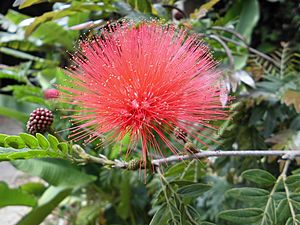Calliandra riparia facts for kids
Quick facts for kids Calliandra riparia |
|
|---|---|
 |
|
| Scientific classification | |
| Genus: |
Calliandra
|
| Species: |
riparia
|
| Synonyms | |
|
|
Calliandra riparia is a type of flowering plant that belongs to the Calliandra group. It is part of the Fabaceae family, which is also known as the pea or bean family. This plant naturally grows in several countries in South America and Central America, including Panama, Colombia, Guyana, and Venezuela.
Contents
What is Calliandra riparia?
Calliandra riparia is a beautiful plant known for its unique flowers. These flowers often look like fluffy pom-poms because of their many long, thin stamens. Stamens are the parts of a flower that produce pollen. The plant is a shrub or a small tree, meaning it can grow as a bushy plant or a small woody plant.
Where Does It Grow?
This plant loves warm, tropical places. It is native to areas with lots of sunshine and rain. You can find it in:
- Panama: A country connecting Central and South America.
- Colombia: A large country in northwestern South America.
- Guyana: A country on the northern coast of South America.
- Venezuela: A country on the northern coast of South America.
It often grows in open areas, along riverbanks (which is why "riparia" is part of its name, meaning "of the riverbank"), or in forests that have been disturbed.
What Does It Look Like?
Calliandra riparia has several interesting features:
- Leaves: Its leaves are usually divided into many smaller leaflets, giving them a delicate, fern-like look. They often fold up at night or when it's very hot.
- Flowers: The flowers are the most striking part. They are often pink or red and look like small, soft brushes or powder puffs. These bright colors attract pollinators.
- Fruits: After the flowers bloom, the plant produces seed pods. These pods are similar to pea pods and contain the seeds for new plants.
The Pea Family: Fabaceae
Calliandra riparia is a member of the Fabaceae family. This is one of the largest families of flowering plants in the world. It includes many plants that are important to humans and animals.
Why is the Fabaceae Family Important?
Plants in the Fabaceae family are special because many of them can take nitrogen from the air and put it into the soil. This process is called nitrogen fixation. Nitrogen is a very important nutrient that helps plants grow strong and healthy.
- Food: Many plants we eat, like peas, beans, lentils, and peanuts, are in this family.
- Soil Health: They help make the soil richer, which is good for other plants growing nearby.
- Wildlife: Many animals eat the leaves, flowers, or seeds of these plants.
Importance of Calliandra riparia
While Calliandra riparia might not be a major food crop, it plays an important role in its natural environment.
Attracting Pollinators
The bright, showy flowers of Calliandra riparia are very attractive to pollinators.
- Bees: Bees visit the flowers to collect nectar and pollen.
- Butterflies: Butterflies are also drawn to the colorful blooms.
- Hummingbirds: In some areas, hummingbirds might feed on the nectar.
Pollinators are essential because they help plants reproduce by carrying pollen from one flower to another. This process allows plants to make seeds and grow new plants.
Habitat and Ecosystem
As a native plant, Calliandra riparia is part of the local ecosystem. It provides:
- Shelter: Its branches can offer shelter for small animals and insects.
- Food Source: Its leaves or seeds might be a food source for certain animals.
- Soil Stability: Growing along riverbanks, its roots can help hold the soil in place, preventing erosion.
See also

- In Spanish: Calliandra riparia para niños

